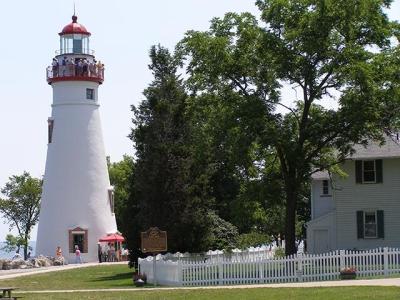
Marblehead Lighthouse is one of Lake Erie's best known and most-photographed landmarks. The grounds surrounding the lighthouse offer excellent picnicking and views of Lake Erie, Sandusky Bay, Kelleys Island and South Bass Island. Marblehead Lighthouse State Park is located at 110 Lighthouse Drive in Marblehead, Ohio.
Other attractions at the site include the Keeper's House Museum and the Lifesaving Station Museum. The site is operated collaboratively between the Ohio Department of Natural Resources and the Marblehead Lighthouse Historical Society, although the U.S. Coast Guard operates and maintains the lighthouse beacon. Refer to their websites for information about dates and times for lighthouse tours and access to the museums. Otherwise, the grounds are open year-round for sight-seeing, picnicking, fishing, bird watching, and relaxing.
Marblehead Lighthouse - the oldest lighthouse in continuous operation on the Great Lakes - has guided sailors safely along the rocky shores of Marblehead Peninsula since 1822.
It's positioned on the tip of the peninsula, a rocky headland of Columbus Limestone that juts into Lake Erie. (“Marblehead” means “marble headland,” because limestone is sometimes incorrectly called marble.)
The Columbus Limestone on the peninsula has been quarried for years and used around the country as a building stone, including for the state capitol building in Columbus. Columbus Limestone is extremely durable; one of its uses is to armor vulnerable sections of shoreline against wave attack. This durability is why the Marblehead Peninsula exists and why the lighthouse has been in continuous operation since its construction. (In contrast, the Cape Hatteras lighthouse in North Carolina was 1,500 feet from the sea when it was built, but had to be moved in 1999 when the sea had encroached to only 120 feet away.)
In 1819, the fifteenth U. S. Congress recognized the need for navigational aides along the Great Lakes, and set aside $5,000 for construction of a light tower at the entrance to Sandusky Bay. Contractor William Kelly built the 50-foot tower of native limestone on the tip of the Marblehead Peninsula. The base of the tower is 25 feet in diameter, with walls five feet thick. It narrows to twelve feet at the top with two-foot thick walls.
Through history, 15 lighthouse keepers, two of whom were women, have tended the beacon. The first keeper was Benajah Wolcott, a Revolutionary War veteran and one of the first settlers on the peninsula. He and his family lived in a small stone home on the Sandusky Bay side of the peninsula. Each night, he lit the wicks of the thirteen whale oil lamps that were the original light fixture. Sixteen-inch-diameter metal reflectors helped project the light across the lake. Other duties of the lighthouse keeper included keeping a log of passing ships, noting the weather conditions, and organizing rescue efforts. Upon Wolcott's death in 1832, his wife, Rachel, took over these duties.
The whale oil lamps were replaced in 1858 by a single, multi-wick lamp and a 4th order fixed Fresnel lens. The lamp and lens produced a bright constant white light focused over the water. Lard oil replaced whale oil as the illuminant in 1866, and kerosene replaced lard oil in 1880.
A lifesaving station was built one-half mile west of the lighthouse in 1876. Lucien Clemons, who with his two brothers saved two sailors from a shipwreck off the peninsula on May 1, 1875, was named the first commander. In 1880 the lighthouse keeper's family moved out of the 1821 limestone house on the lighthouse grounds to a newly-built two-story wooden frame house on the property. The former house was then demolished.
Between 1897 and 1903, the tower's height was increased 15ft by the addition of a watchroom and new lantern room. A new, larger, rotating Fresnel lens apparatus powered by a clockwork produced a bright flash of light every 10 seconds. Through the night, the keeper had to crank the weight to the top and adjust the timing every 3 hours to keep the lens rotating on schedule.
Modern conveniences came slowly to the timeless light tower. An electric light finally replaced the kerosene lantern in 1923, dramatically increasing the candlepower of the signal. During World War II, the lighthouse became strategically important for national defense. The last civilian lighthouse keeper resigned and the United States Coast Guard assumed responsibility for the beacon in 1946.
The beacon was automated in 1958, making the Coast Guard's job easier. With its original finish tattered by time and harsh weather, the exterior of the lighthouse tower was given a fresh coat of new stucco the same year.
The Ohio Department of Natural Resources has maintained the property surrounding the lighthouse since 1972 and proudly accepted ownership of the Marblehead Lighthouse tower in May 1998. The U.S. Coast Guard continues to operate and maintain the lighthouse beacon. Today's technology features a new LED light projecting a green signal that flashes every six seconds and is visible for 11 nautical miles. The distinctive green distinguishes the lighthouse signal from white lights coming from air beacons.
Marblehead's beloved beacon continues to shine and protect boaters from peril in Lake Erie's unpredictable waters along her rocky shores.